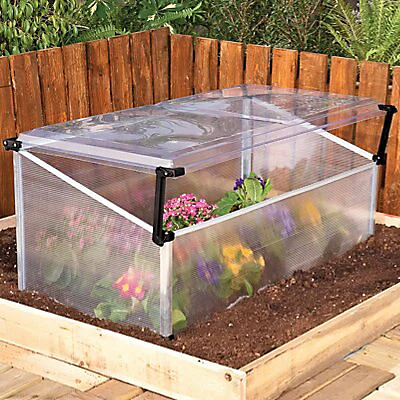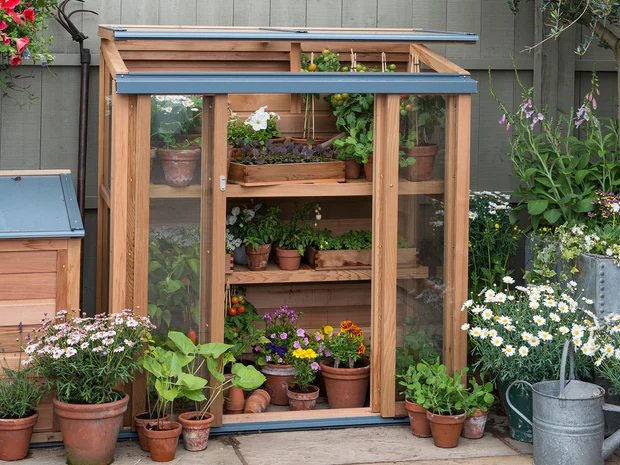While the autumn weather may be warmer than usual, it’s fair to say cooler temperatures are just around the corner. Cold Frames and Cloches are an excellent way to prolong your growing season despite the cold climate, and they can help your tender favourite last until next year:
Read on to discover the easiest and best ways to care for your plants and garden this winter…
Cold frames are like winter greenhouses in that they’re solid structures designed to protect tender plants and keep them warm in inclement weather. The main difference is the size of a cold frame. They’re usually much smaller and stand closer to the ground surface for plants to make the most of ground heat while enjoying protection from the elements.
They’ve been used for centuries in gardening and home improvements, and older versions are often seen in large manor houses and kitchen gardens, like those unearthed in the Lost Gardens of Heligan in Cornwall.
Cold frames come in a range of materials, such as wood, metal, glass, polycarbonate and more. The different materials affect the efficacy, for example, glass lets through more light while polycarbonate panes do less but are generally more hardwearing and long-lasting.
The kind you choose should suit your needs.
When to use Cold Frames
The main purpose of cold frames is protection. Protection from cold weather, like frost, and protection while seedlings harden off to outdoor climates.
In Spring:
Most gardeners use them to harden off their spring and summer seedlings for outdoor planting. They act as a mid-way between indoor warmth and outdoor exposure to help tender or less hardy seedlings acclimate.
In Summer:
Cold frames are typically used as a propagator in summer to help give seeds or cuttings the warmth and moisture they need to thrive. It’s important to assess the temperature and look out for mould growth in summer use – opening the cold frame roof or sides to ventilate everything out for a while certainly helps.
In Autumn:
They are used in autumn to extend the summer growing season and protect your tender plants from the first mild frosts.
In Winter:
The warmth and weather protection provided by Cold Frames makes them ideal for overwintering plants like alpines or for looking after early sown seeds for spring flowering.
How to use Cold Frames
There are a couple of ways to use your cold frame:
- On solid ground for potted plants and seeds.
- Over soil for both bedded and potted plants.
For potted plants, ensure they don’t dry out or the atmosphere gets too humid. This means regular watering and checking to ensure you aren’t doing too much or too little.
For sowing directly in the ground, make sure there is a nice thick layer of seed-sowing compost and that the conditions are suited to your crop. Again, water and check regularly to ensure it’s not waterlogged or dried out.
Ventilation and watering are key when using cold frames, so check the weather and regularly assess the conditions inside with a thermometer and soil moisture detector.

What is a garden cloche?
A garden Cloche is like a cold frame but much smaller. A classic cloche is usually installed over a single bedded non-hardy plant to offer protection over winter or extend the growing season of your crop. It’s ideal for those who don’t want a permanent structure like a cold frame or greenhouse in their garden.
They are called cloches for their bell-like shapes, as the French word for bell is cloche. Though, nowadays they often come in different shapes and sizes.
Typically, you’ll find them crafted from a range of materials, though glass ones are most preferred due to their clear, see-through, and thicker structure, allowing in more light and providing more protection.
However, plastic ones are becoming more popular as they often come with additional features like detachable ventilation hatches, adjustable ventilation holes and more hardwearing materials.
Furthermore, flexible cloche or cold frame-like structures called protection tunnels are now quite popular, as well. These are PVC-covered frames you can unfold and position where you need – much like a modern-day tent for plants. The benefit is that they often come with different covering materials, like fleece or netting for other seasonal uses. Other benefits include how they can be installed in minutes, then dismantled and stored away flat-packed until their next use.
What is Horticultural Fleece?
Sometimes a plant is much larger than a cloche or a cold frame, but you still need to offer them winter protection. That’s where horticultural fleece comes in.
Horticultural fleece is a lightweight ‘spun bonded’ material made from polypropylene. It’s fashioned into a soft, warm fleece-like material and sold in sheets or rolls, much like actual fabrics.
It was developed to replace polythene sheeting, which was not ideal for winter use due to its likelihood of overheating and lack of insulation in winter. This thicker, more porous material aims to provide insulation as well as airflow to tender plants to avoid trapping heat or moisture, which can lead to pests and rotting or mould problems.
To use it, cut it to size and wrap or drape it around your tender plants. Do not wrap it tightly – the trapped air will act as additional insulation and allow for more airflow. You can use garden supports to create a framework surrounding your plant to wrap the fleece around to avoid direct contact.
For frost protection, ensure your fleece is thick enough and pin it to the ground for security.
Make sure to regularly check your fleeced plants for disease or issues and unwrap them as soon as the threat has passed.
Other winter garden maintenance
As well as protecting your tender plants from the harsh winter weather and prepping seeds for the coming year, there are several other garden maintenance jobs you can get done in winter to make the coming year easier.
1. Clean your tools
In the other months, your tools get used an incredible amount, so taking a bit of your wintertime to give everything a good clean and disinfect is good practice and helps them last that much longer.
2. Sharpen your tools
From lawn mower blades to trowels, spaces, pruners and more, gardening requires a lot of cutting and sharp edges. Sharpening your tools carefully using a file in winter after cleaning can help ensure cleaner, easier cuts in the coming year.
3. Clean off algae and moss growth
Steps, patios and other stone or tile work in your outside space can get covered in slippery green algae and moss in winter due to the lack of natural sunlight to battle it. There’s no need to use a chemical cleaner, though – giving your stonework a good clean and scrub with nature-friendly soap and warm water will remove the problem in no time and keep your garden safe for you and the local wildlife.
4. Provide for your local wildlife
Birds, hedgehogs, squirrels and more suffer in winter due to a lack of food available, so providing shelter, water and food for your local wildlife is a great idea to help improve biodiversity in your garden and help them thrive.
5. Plan for the year ahead
A garden can boost the appeal of a home, so why not take some time and plan out your gardening activity for the coming year? Are you installing a hedge? Digging a new border? Growing some new veg? Starting to compost? Introducing sustainable gardening practices?
Take a bit of time to plan out what you want for your space next year, then check your timings and plan out how you can accomplish it.

